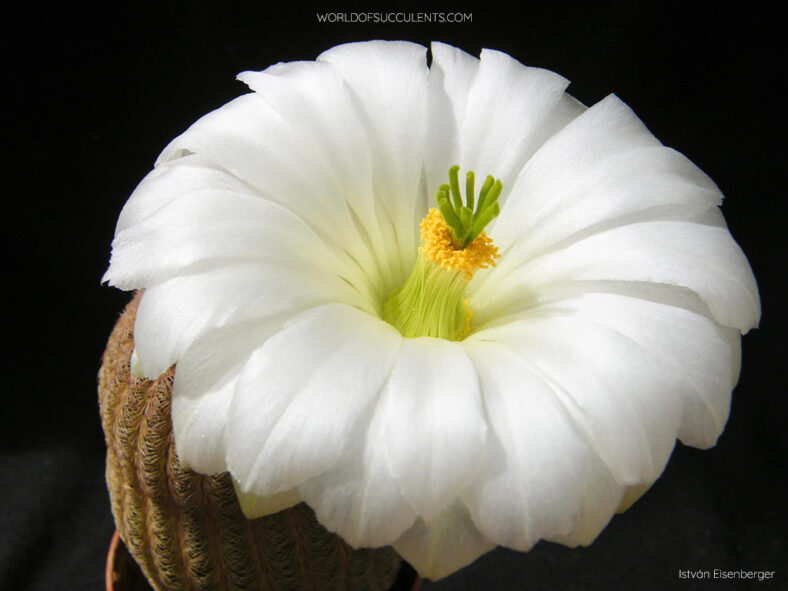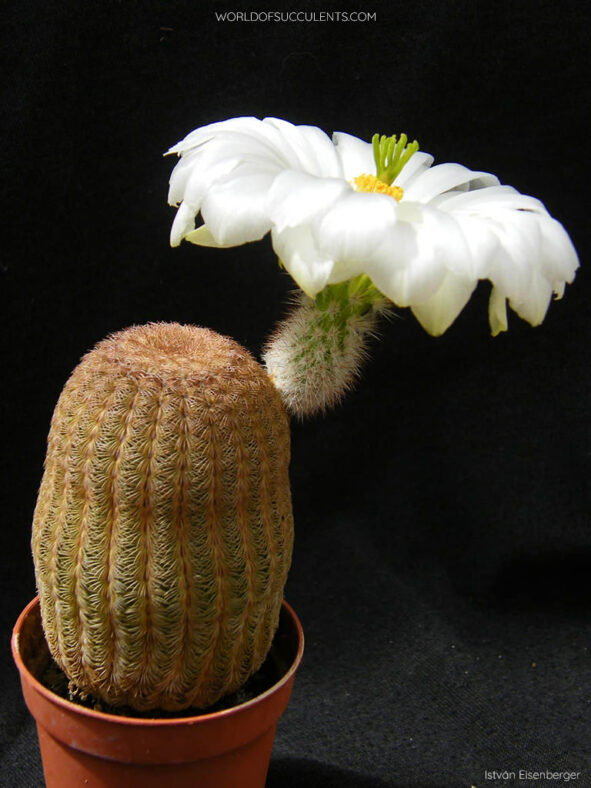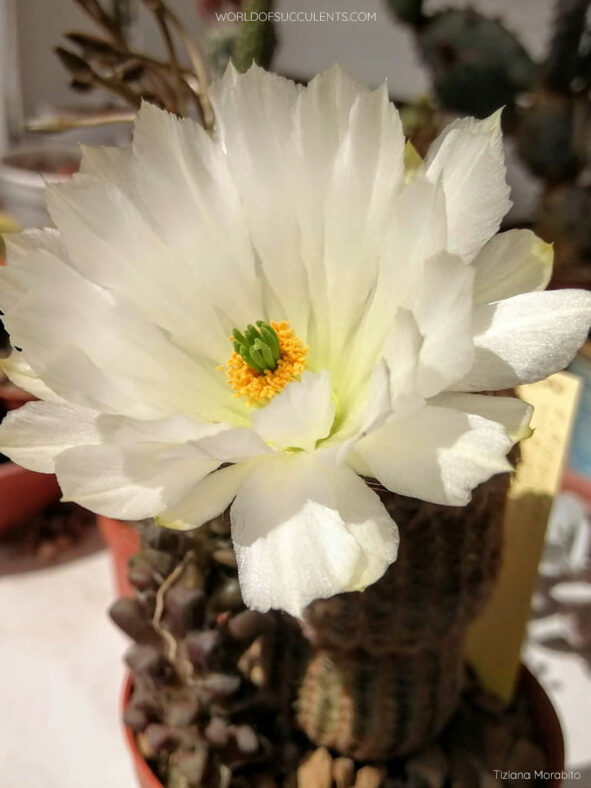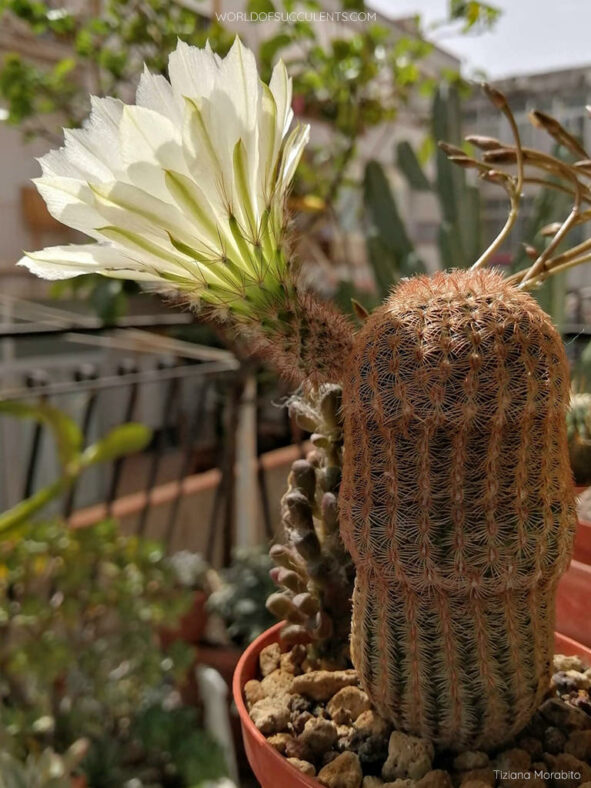Echinocereus rigidissimus subsp. rubispinus 'Albiflorus' is usually sold as Echinocereus rigidissimus var. albiflorus. In Europe, it is also sold as Echinocereus rigidissimus subsp. rubispinus 'Karl Werner Beisel'.
Scientific Name
Echinocereus rigidissimus subsp. rubispinus 'Albiflorus'
Accepted Scientific Name
Echinocereus rigidissimus subsp. rubispinus
Synonym(s)
Echinocereus rigidissimus subsp. rubispinus f. albiflorus, Echinocereus rigidissimus var. albiflorus, Echinocereus rigidissimus subsp. rubispinus 'Karl Werner Beisel'
Scientific Classification
Family: Cactaceae
Subfamily: Cactoideae
Tribe: Pachycereeae
Genus: Echinocereus
Etymology
The cultivar epithet "albiflorus (pronounced al-BIH-flor-us)" means "white-flowered" and refers to the color of the flowers.
Origin
This cactus is a form of Echinocereus rigidissimus subsp. rubispinus selected for its white flowers.
Description
Echinocereus rigidissimus subsp. rubispinus 'Albiflorus' is a beautiful, small cactus with an erect, cylindrical stem nearly hidden by the closely set, cream-colored to pinkish-yellow spines. The stem has 15 to 26 ribs and grows solitary initially, then produces offsets, forming a small clump with age. It can reach a height of 10 inches (25 cm) and a diameter of 2.8 inches (7 cm). Each areole bears 30 to 35 pectinately arranged radial spines flat against the stem. The central spines are absent.
The beautiful white flowers are funnel-shaped and can reach up to 3.2 inches (8 cm) in length and 3.6 inches (9 cm) in diameter. They appear near the top of the stem in late spring and summer. The fruits are spiny, greenish or purple-brown, with white pulp and tiny black seeds. They are spherical and can grow up to 1.2 inches (3 cm) in diameter.

How to Grow and Care for Echinocereus rigidissimus subsp. rubispinus 'Albiflorus'
Light: This cactus needs bright light to perform its best. It can handle partial shade but thrives in full sun during the summer. A sunny window is a good spot to grow E. rigidissimus subsp. rubispinus 'Albiflorus' indoors. Rotate the container a quarter turn every week or two to encourage balanced growth. If possible, get it outdoors from spring to fall.
Soil: Good drainage is essential for a healthy plant. E. rigidissimus subsp. rubispinus 'Albiflorus' does not like "wet feet" and needs to be grown in well-draining soil. You can use commercial soil mixes for cacti or make your own mix.
Hardiness: From spring to fall, during its growing season, this cactus likes warm temperatures, while in winter, it likes cooler temperatures. E. rigidissimus subsp. rubispinus 'Albiflorus' can withstand temperatures as low as 20°F (-6.7°C). USDA Plant Hardiness Zones 9a to 11b, 20°F to 50°F (-6.7°C to 10°C).
Watering: Water thoroughly from spring to fall, but allow the soil to dry before watering again. With the arrival of fall, gradually reduce the watering frequency. When this cactus is dormant in winter, give it just enough water to prevent shrinking.
Fertilizing: During its growing season, this cactus likes regular fertilizing. A balanced, water-soluble fertilizer, diluted to 1/4 strength, can be added to each watering. A 10-10-10 fertilizer is ideal. Do not fertilize during the winter.
Repotting: While E. rigidissimus subsp. rubispinus 'Albiflorus' is young, repot each year in early spring. Once it matures, repot when it is outgrowing its container.
Propagation: This cactus is easy to propagate by offsets. The best time to remove offsets is in spring and summer.
Learn more at How to Grow and Care for Echinocereus.
Toxicity of Echinocereus rigidissimus subsp. rubispinus 'Albiflorus'
E. rigidissimus subsp. rubispinus 'Albiflorus' is non-toxic to humans or animals.
Links
- Back to genus Echinocereus
- Succupedia: Browse succulents by Scientific Name, Common Name, Genus, Family, USDA Hardiness Zone, Origin, or cacti by Genus
Photo Gallery
Click on a photo to see a larger version.


